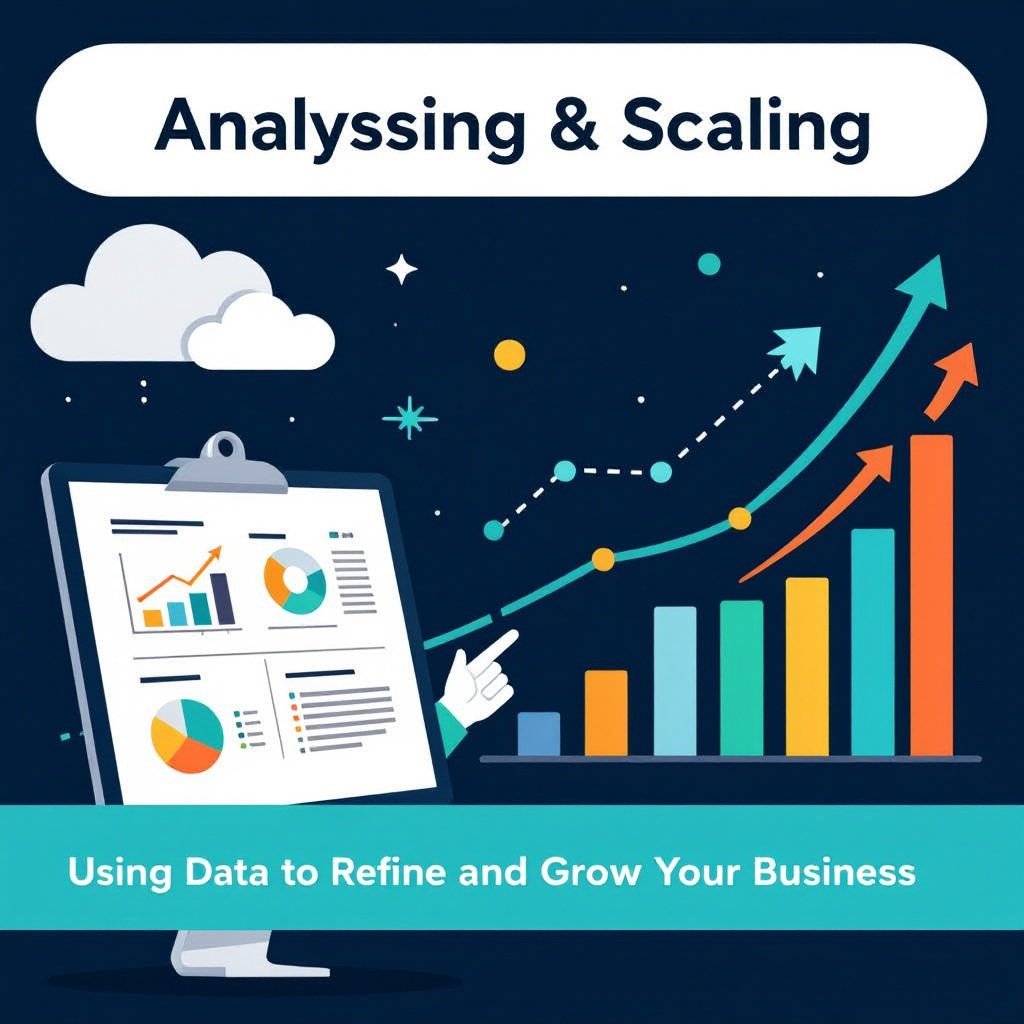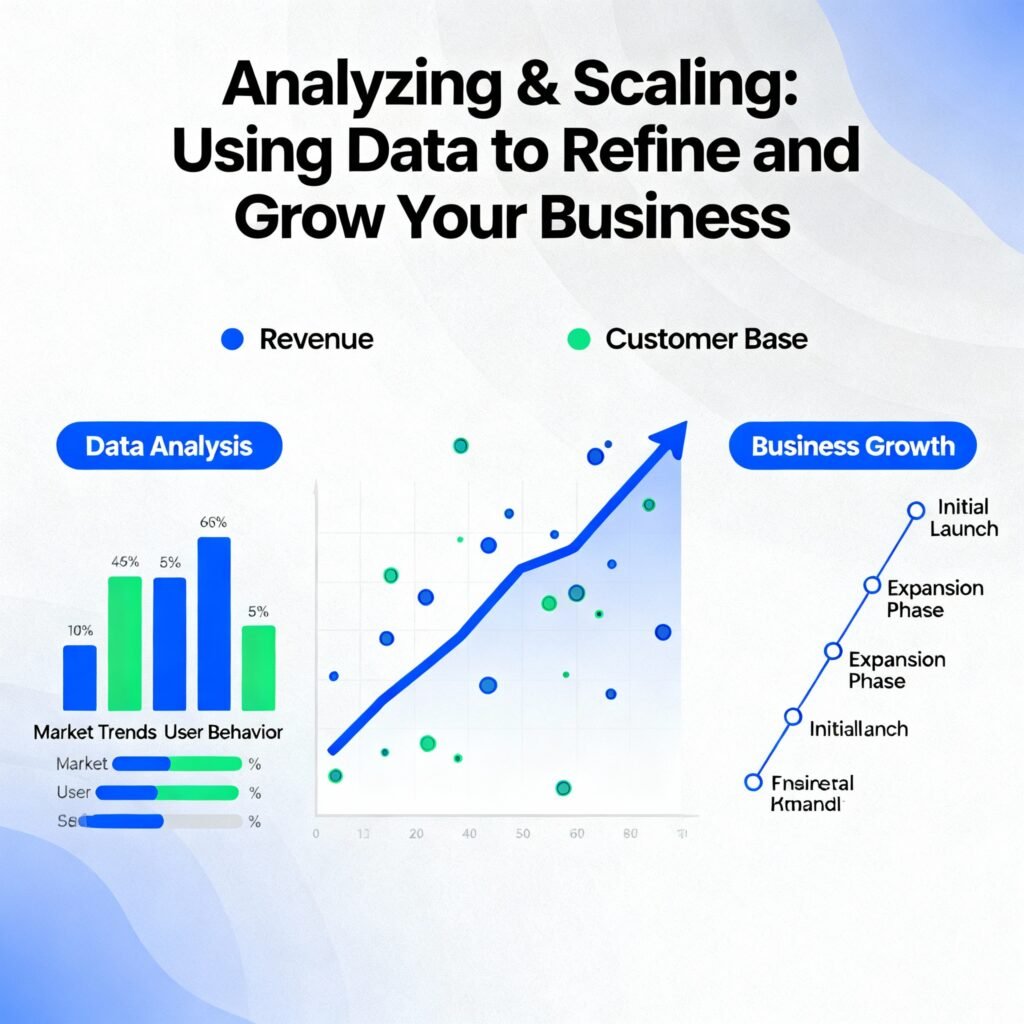
In the world of digital marketing, analyzing and scaling are the keys to sustainable growth. Businesses that regularly track performance data, review campaign results, and adjust strategies based on insights consistently outperform those that rely on guesswork. By learning how to collect, analyze, and apply data effectively, you can refine your marketing efforts, reduce wasted ad spend, and scale your business to new heights.
Table of Contents
- From Intuition to Intelligence: The Data-Driven Mindset
- Your Data Command Center: Essential Tools
- What to Measure: KPIs for Each Stage of the Journey
- The Analysis Cycle: Ask, Investigate, Act
- From Insight to Action: Scaling What Works
- Conclusion: Building a Self-Improving Marketing Machine
1. From Intuition to Intelligence: The Data-Driven Mindset
You’ve built a formidable arsenal. You’re creating content, running ads, growing a community, and nurturing an email list. But how do you know if any of it is actually working? Are you investing time and money into the right channels?
This is where marketing transforms from an art into a science. Growth isn’t about doing more; it’s about doing more of what works. The bridge between activity and results is data.
A data-driven mindset means:
- Replacing “I think” with “I know.” You move from gut feelings to evidence-based decisions.
- Focusing on outcomes, not outputs. It’s not about publishing 10 blog posts; it’s about which one generated 80% of your leads.
- Embracing experimentation. Every piece of data is a clue, telling you what to try next.
This post will show you how to read those clues, refine your strategy, and systematically scale your success.
2. Your Data Command Center: Essential Tools
You can’t analyze what you don’t track. Here are the non-negotiable tools for your data stack.
Google Analytics 4 (GA4): The Foundation
GA4 is your window into your website’s performance. It tells you not just who visits, but what they do.
- Key Uses: Track traffic sources, user behavior, conversions (e.g., purchases, sign-ups), and audience demographics.
- Critical Setup: Ensure Google Tag Manager is installed to easily manage tracking tags and conversion events are properly configured. This is the bedrock of all analysis.
Platform-Specific Insights
- Google Search Console: The ultimate SEO tool. Shows what keywords you rank for, your click-through rate (CTR) from search, and technical site health.
- Social Media Analytics (Meta Business Suite, LinkedIn Analytics, etc.): Provide deep insights into post engagement, audience growth, and follower demographics.
- Email Marketing Platform (Mailchimp, ConvertKit, etc.): Track open rates, click-through rates, and conversion rates for every campaign.
The Power of a Simple Dashboard
You don’t need to live in 10 different tabs. Use Google Looker Studio (formerly Data Studio) or a similar tool to create a simple dashboard that pulls your most important KPIs (Key Performance Indicators) into one place. This gives you a single source of truth for your marketing performance.
3. What to Measure: KPIs for Each Stage of the Journey
Not all metrics are created equal. You must track metrics that align with your goals at each stage of the customer journey.
Awareness & Acquisition (Top of Funnel)
- Website Traffic: Total users and new users.
- Traffic Sources: Where are they coming from? (Organic search, social, paid ads, direct)
- Channel-Specific Metrics: Social media reach, video views, impressions.
Engagement & Consideration (Middle of Funnel)
- Engagement Rate: (Likes, comments, shares) / impressions.
- Click-Through Rate (CTR): Clicks / impressions (for ads and emails).
- Average Session Duration: How long do people stay on your site?
- Pages per Session: How deeply are they engaging with your content?
Conversion & Retention (Bottom of Funnel)
- Conversion Rate (CVR): The percentage of visitors who complete a desired goal.
- Cost Per Acquisition (CPA): How much you pay to acquire a customer or lead.
- Customer Lifetime Value (LTV): The total revenue you expect from a customer over time.
- Email Open Rate & Click Rate: Is your audience still engaged?
- Churn Rate: The percentage of customers you lose over a period.
The Golden Metric: The ratio of LTV to CPA. If a customer is worth significantly more than it costs to acquire them, you have a sustainable growth model.
4. The Analysis Cycle: Ask, Investigate, Act
Analysis isn’t a monthly report. It’s a continuous cycle of curiosity.
Step 1: Ask the Right Questions
Start with a business question, not a data point.
- “Where are our highest-quality leads coming from?”
- “Which blog topic drives the most email sign-ups?”
- “Is our new Facebook ad creative better than the old one?”
- “Why did sales dip last week?”
Step 2: Investigate the Data
Use your tools to find answers.
- In GA4, use the “Acquisition” report to see which channel has the highest conversion rate.
- In Google Search Console, see which keywords have a high impression count but low CTR—this is an opportunity to rewrite your meta description.
- In your email platform, sort campaigns by click rate to see which subject lines and content resonated most.
Step 3: Act on Your Findings
This is the most important step. Data is useless without action.
- If you find that “how-to” guides convert readers into email subscribers 5x better than “industry news” posts → Then act by shifting your content calendar to create more how-to guides.
- If you find that Google Ads have a lower CPA than LinkedIn Ads for your product → Then act by reallocating your budget from LinkedIn to Google.
5. From Insight to Action: Scaling What Works
Scaling is the process of applying more fuel to your most efficient engines.
The Rule of Double-Down
The 80/20 rule (Pareto Principle) is often true in marketing: 80% of your results come from 20% of your efforts. Your job is to find that 20% and double down on it.
Scaling Levers: Budget, Content, and Audience
- Scale Budget: Found a winning ad campaign? Increase its daily budget incrementally while monitoring CPA.
- Scale Content: Found a blog post that’s a massive SEO traffic driver? Turn it into a YouTube video, an infographic, a webinar, and a lead magnet. Repurpose the winner.
- Scale Audience: Found a high-value customer segment on Facebook? Create a Lookalike Audience to find more people just like them.
When to Pivot: Killing What Doesn’t Work
Being data-driven also means having the courage to stop. If a channel, campaign, or content type consistently underperforms (after sufficient testing), stop doing it. Pivot those resources into your winning strategies.

6. Conclusion: Building a Self-Improving Marketing Machine
You have now closed the loop. This series has taken you through the entire lifecycle of modern marketing:
- Attract strangers with SEO and Content.
- Engage them with Community and Social Media.
- Convert them into leads and customers with Email and Paid Ads.
- Analyze everything to see what’s working.
- Scale the winners and refine the rest.
This process is not linear; it’s a flywheel. Each piece fuels the next. The data from your analytics informs your content strategy, which improves your SEO, which provides more data to analyze.
By adopting this data-driven, test-and-learn approach, you are no longer just doing marketing. You are building a self-improving marketing machine that systematically drives growth and ensures every effort moves the needle for your business.
Now, go make it happen.